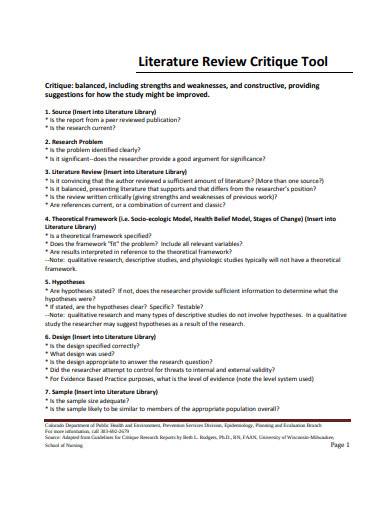
Table of contents
15/09/ · The names of the sorted articles will become your headings for each of the paragraphs that you write in the body of your review. The body of your literature review will include, a. Theme 1: a paragraph or several paragraphs that describe the first theme that you identified and compare, contrast and/or connect the articles you’ve selected. b 09/06/ · A literature review is NOT a research proposal. Do not explain the method, state the subject, etc. Instead, focus on the central issues reported in current related research and discuss their features. A literature review is NOT a research paper. Do not develop a new argument and add any original contribution 15/06/ · Write in proper format (e.g. APA, MLA, Chicago, etc.) Decide on a topic; Identify the literature for review. Use relevant databases; Redefine topic as needed; Include classic studies in your field and/or those relevant to your topic; Import literature into RefWorks or similar sources management software (check your institution’s library website)

�� Literature Review Outline: General Information
09/06/ · A literature review is NOT a research proposal. Do not explain the method, state the subject, etc. Instead, focus on the central issues reported in current related research and discuss their features. A literature review is NOT a research paper. Do not develop a new argument and add any original contribution Therefore, the central purpose of a review is to share original ideas related to a scholarly message. A literature review has four main elements: A valid and substantial resource description. A brief explanation of central themes of interest (author's main message). Deep analysis of gaps in the research. Analysis of themes of interest If your lit review is a standalone piece, the introduction and conclusion take up more space and give you a place to discuss your goals, research methods, and conclusions separately from where you discuss the literature itself. Introduction: An introductory paragraph that explains what your working topic and thesis is

Contact Our Experienced Writing Team For Quality Writing Support
Therefore, the central purpose of a review is to share original ideas related to a scholarly message. A literature review has four main elements: A valid and substantial resource description. A brief explanation of central themes of interest (author's main message). Deep analysis of gaps in the research. Analysis of themes of interest 15/06/ · Write in proper format (e.g. APA, MLA, Chicago, etc.) Decide on a topic; Identify the literature for review. Use relevant databases; Redefine topic as needed; Include classic studies in your field and/or those relevant to your topic; Import literature into RefWorks or similar sources management software (check your institution’s library website) 15/09/ · The names of the sorted articles will become your headings for each of the paragraphs that you write in the body of your review. The body of your literature review will include, a. Theme 1: a paragraph or several paragraphs that describe the first theme that you identified and compare, contrast and/or connect the articles you’ve selected. b

References
15/09/ · The names of the sorted articles will become your headings for each of the paragraphs that you write in the body of your review. The body of your literature review will include, a. Theme 1: a paragraph or several paragraphs that describe the first theme that you identified and compare, contrast and/or connect the articles you’ve selected. b 09/06/ · A literature review is NOT a research proposal. Do not explain the method, state the subject, etc. Instead, focus on the central issues reported in current related research and discuss their features. A literature review is NOT a research paper. Do not develop a new argument and add any original contribution If your lit review is a standalone piece, the introduction and conclusion take up more space and give you a place to discuss your goals, research methods, and conclusions separately from where you discuss the literature itself. Introduction: An introductory paragraph that explains what your working topic and thesis is

Reflection & transparency in the process
Therefore, the central purpose of a review is to share original ideas related to a scholarly message. A literature review has four main elements: A valid and substantial resource description. A brief explanation of central themes of interest (author's main message). Deep analysis of gaps in the research. Analysis of themes of interest 01/10/ · How to write up your literature review Step 1: Find the relevant literature Naturally, the first step in the literature review journey is to hunt down the existing research that’s relevant to your blogger.comted Reading Time: 7 mins 15/06/ · Write in proper format (e.g. APA, MLA, Chicago, etc.) Decide on a topic; Identify the literature for review. Use relevant databases; Redefine topic as needed; Include classic studies in your field and/or those relevant to your topic; Import literature into RefWorks or similar sources management software (check your institution’s library website)
No comments:
Post a Comment